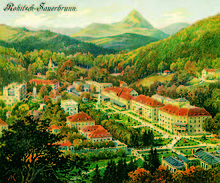Rogaška Slatina
Rogaška Slatina | |
|---|---|
 Spa Square (Zdraviliški trg), the central square in Rogaška Slatina | |
 Rogaška Slatina Location in Slovenia | |
| Coordinates: 46°13′53.44″N 15°38′16.783″E / 46.2315111°N 15.63799528°E / 46.2315111; 15.63799528Coordinates: 46°13′53.44″N 15°38′16.783″E / 46.2315111°N 15.63799528°E / 46.2315111; 15.63799528 | |
| Country | |
| Traditional region | Styria |
| Statistical region | Savinja |
| Municipality | Rogaška Slatina |
| Area | |
| • Total | 5.4 km2 (2.1 sq mi) |
| Elevation | 223.6 m (733.6 ft) |
| Population (2014) | |
| • Total | 5,041 |
| Climate | Cfb |
| [1] | |
Rogaška Slatina (pronounced [ɾɔˈɡaːʃka ˈslaːtina] (![]() listen); German: Rohitsch-Sauerbrunn[2]) is a town in eastern Slovenia. It is the largest settlement and the centre of the Municipality of Rogaška Slatina. It is known for its curative mineral water, spa, and crystal glass.
listen); German: Rohitsch-Sauerbrunn[2]) is a town in eastern Slovenia. It is the largest settlement and the centre of the Municipality of Rogaška Slatina. It is known for its curative mineral water, spa, and crystal glass.
Contents
1 Name
2 History
2.1 Mass graves
3 Spa
4 Churches
5 Notable people
6 References
7 External links
Name
The name Rogaška Slatina literally means 'Rogatec springs', referring to a source of mineral water.[3] The springs were dubbed Roitschocrene 'Rogatec springs' (< Greek κρήνη crene 'spring') in 1687 by Johann Benedikt Gründel. The settlement was known as Rohitsch-Sauerbrunn or Sauerbrunn Curort in German[2] (and in older sources also Roitscher Sauerbrunn).[4][5] Older sources also contain the Slovene names Slatina Zdravišče and Slatina Rogačka.[2]
History

Rogaška Slatina on an early-20th-century postcard
The Rogaška Slatina area was inhabited in antiquity, and a Roman road led to the settlement. A document from the Archbishopric of Salzburg dating from 1141 mentions a Roman stone next to a spring in the settlement. The 16th-century alchemist Leonhard Thurneysser was the first to describe the spring.[6]
Mass graves
Rogaška Slatina is the site of two known mass graves from the period immediately after the Second World War. The Sovinec Ravine Mass Grave (Slovene: Sovinčev graben) is located in the southeast part of the town, in a ravine above the railroad tracks. It contains the remains of 18 to 20 Croatians that were hunted down and murdered at the site in May and June 1945.[7] The Flower Hill Mass Grave (Grobišče Cvetlični hrib) lies east of the town and is believed to occupy the entire ravine below the former Triglav Hotel. It contains the remains of an unknown number of victims murdered after the war.[8]
Spa

In the front, The Donat spring; in the background, the neoclassical Tempel Pavilion (1819, Nikola Pertsch)
Rogaška Slatina is a synonym for health-resort tourism in Slovenia. For centuries the curative mineral water rich in magnesium (branded as Donat Mg), the picturesque countryside, and other local attractions have attracted visitors to the area. Roman inscriptions referring to the spa waters have been found.[9]
Churches

Holy Cross Parish Church in Rogaška Slatina
The parish church in the town is dedicated to the Holy Cross and belongs to the Roman Catholic Diocese of Celje. It was built between 1864 and 1866 in a Neo-Romanesque style.[10]
Another church, next to the village of Prnek, is dedicated to the Holy Trinity. It also belongs to the Parish of Rogaška Slatina. It was built in the 17th century and contains a gold-plated altar dating to between 1650 and 1675. The rest of the internal furnishings are from the 18th and 19th centuries.[11]
Notable people
Notable people that were born or lived in Rogaška Slatina include:
Hilarij Froelich (1811–1878), medical writer[6]
Franjo Kolterer (1888–1964), medical writer[6]
Avgust Lavrenčič (1925–1996), painter and scenographer[6]
Ela Peroci (1922–2001), children's writer[6]
Miloš Verk (1890–1952), cartographer[6]
References
^ Statistical Office of the Republic of Slovenia
^ abc Leksikon občin kraljestev in dežel zastopanih v državnem zboru, vol. 4: Štajersko. 1904. Vienna: C. Kr. Dvorna in Državna Tiskarna, p. 248.
^ Snoj, Marko. 2009. Etimološki slovar slovenskih zemljepisnih imen. Ljubljana: Modrijan and Založba ZRC, pp. 379–380.
^ Gründel, Johann Benedikt. 1687. Roitschocrene, Das ist: Außführliche Beschreibung Deß In Unter-Steyer weit-berühmbten Roitischen Sauerbrunn. Graz: Widmannstetter.
^ "Nichts über eine gute Hausmannskost." 1840. Der bayerische Volksfreund 68 (20 March), p. 541.
^ abcdef Savnik, Roman, ed. 1976. Krajevni leksikon Slovenije, vol. 3. Ljubljana: Državna založba Slovenije. pp. 385–386.
^ Sovinec Ravine Mass Grave on Geopedia (in Slovene)
^ Flower Hill Mass Grave on Geopedia (in Slovene)
^ Rogaška Slatina municipal site
^ Slovenian Ministry of Culture register of national heritage reference number 3080
^ Ministry of Culture register of national heritage reference number 3081
External links
| Wikimedia Commons has media related to Rogaška Slatina. |
- Rogaška Slatina, the official travel guide to Slovenia
- Rogaška Slatina on Geopedia
- Rogaška Slatina municipal site
